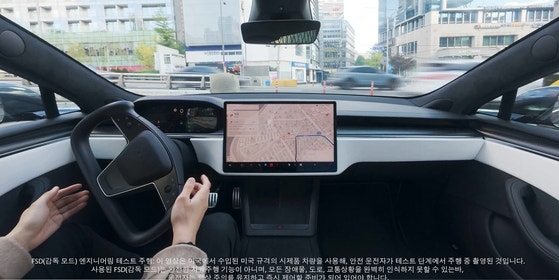
Tesla announced plans to launch its Full Self-Driving (FSD) feature in Korea on Wednesday, generating buzz over the introduction of the “supervised FSD" version that offers some autonomous driving under the premise of driver oversight.
However, as concerns over safety continue to emerge even in North America, where the system has already been commercialized, experts say Korea must conduct thorough reviews of its own self-driving environment alongside the rollout.
Tesla Korea posted a message on its official X account that read, “FSD Supervised, Next Destination: Korea, Coming soon,” along with a test drive video filmed in downtown Seoul.
The footage showed what appeared to be a Model S or Model X navigating the area around a Han River park, exiting the toll gates, entering underpasses and maneuvering through narrow alleyways — all without driver intervention.
Tesla clarified that the test used a U.S.-made prototype vehicle and was conducted with a test driver in the car. The company emphasized that supervised FSD is not full autonomy and that the driver must always remain alert to road conditions and be ready to take control at any moment.
Already commercialized in North America, supervised FSD is a more advanced system than Tesla’s Autopilot. Using eight onboard cameras and an AI-powered computation system, the vehicle can recognize traffic signals, pedestrians and intersections in real time. A driver-monitoring camera mounted on the rearview mirror tracks eye movement and issues alerts when attention drifts.
This optional extra corresponds to Level 2 to 2+ autonomy, according to the Society of Automotive Engineers and will come with a price of 9.04 million won ($6,160).
To prepare for its rollout in Korea, Tesla Korea has been laying the groundwork since the launch of the Model 3 in 2019 by collecting domestic traffic signal data and separating Autopilot and FSD as distinct options. More recently, the company began requesting customer consent to share driving data, which is being used to enhance its performance.
Tesla’s FSD is widely regarded as more advanced than Hyundai Motor’s autonomous driving technology. However, technological superiority does not guarantee safety. Not only do Korea and the United States have different safety standards, but concerns over FSD’s safety continue to emerge in the United States as well.
In fact, the U.S. National Highway Traffic Safety Administration is currently investigating recent reports of Tesla vehicles running the latest version of FSD that allegedly ran red lights or exceeded speed limits.
From a regulatory standpoint, Korean traffic law does not permit drivers to remove their hands from the steering wheel or to change lanes automatically. This means the demonstration video released by Tesla — showing a driver keeping their hands near the wheel without direct contact — depicts behavior that is not legally permissible under current domestic regulations.
FSD will not be immediately available on all Tesla vehicles currently operating in Korea. The majority of local sales are Model 3 and Model Y units manufactured at the Shanghai Gigafactory, which are built to meet European safety standards.
By contrast, the test vehicle used in this demonstration was made in the United States, allowing for a different import procedure. Under the Korea-U. S. FTA, up to 25,000 U.S.-made cars that meet U.S. safety standards can be imported into Korea without meeting local standards, per year through a self-certification system.
Vehicles manufactured in China would require additional compliance with domestic safety and traffic regulations for FSD to be formally implemented.
“Tesla has not yet held any formal discussions with the government regarding the introduction of FSD,” said an official from the Ministry of Land, Infrastructure and Transport.
Industry insiders note that Tesla’s selection of Korea as the first country in Asia for FSD could accelerate a push for broader implementation.
“The fact that FSD underwent real-world testing in urban Korea alone could be a significant catalyst for the automobile industry and regulatory framework,” said one automotive industry source. “With global players speeding up commercial autonomous driving, domestic policy discussions can no longer be postponed.”
Experts note that full commercialization of autonomous driving will hinge on both technological safety and alignment with legal standards.
“Technically, supervised FSD is close to full autonomy,” said Lee Ho-geun, a professor of automotive engineering at Daeduk University. “But since it still requires driver intervention, it remains a partial automation system. Without regulatory reforms — such as those permitting hands-free driving or automatic lane changes — broad commercialization in Korea will be difficult to achieve.”
This article was originally written in Korean and translated by a bilingual reporter with the help of generative AI tools. It was then edited by a native English-speaking editor. All AI-assisted translations are reviewed and refined by our newsroom.
댓글목록
등록된 댓글이 없습니다.